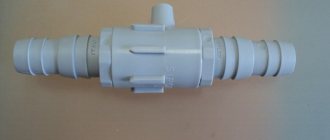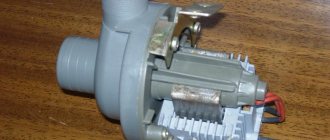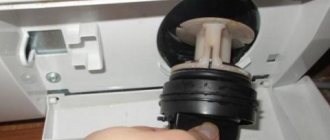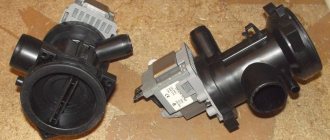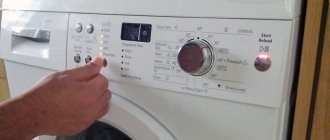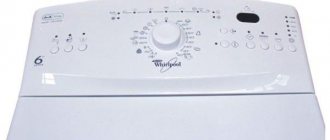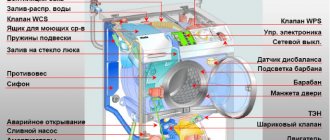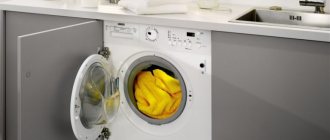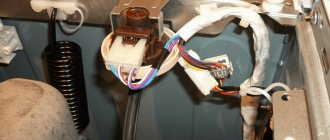Drain hose
The simplest method allows you to drain the water the fastest. Procedure:
- Turn off the power, turn off the water supply.
- Disconnect the drain hose from the rear panel.
- Pull the outlet out of the sewer pipe.
- Place the end of the hose in a container (bowl or basin) located below the level of the washing tank. The container required is low; it is difficult to pour into a bucket using this method.
If the washing machine does not drain water in this way, then it is equipped with protection against leakage from the sewer hose.
Inside the housing, manufacturers make an additional loop with a drain hose or install a plastic elbow, so the drain hose is always above the level of the tank. Most often found in Bosh and Siemens washing machines. See also -
Samsung washing machine fault codes
Connection to the sewer system using a siphon
To connect the drainage system this way, you need to install a siphon high under the sink. This will prevent water from returning to the machine. It is not easy to connect the drain under the sink; if the drain hose is short, it needs to be extended. The maximum size is indicated in the instructions for the machine. The only drawback of extension is the increased load on the pump. An additional section of the hose increases water pumping and the pump wears out faster.
Connection to the sewerage system via a siphon.
The plastic siphon is equipped with a pipe to which the hose is connected. This connection must be secured with a coupling in order to prevent the penetration of unpleasant sewer odors into the machine and to seal the connection. The drain pipe allows water to enter the drain pump.
With this connection, dirty water is drained into the sewer without hindrance. There are no water leaks under the siphon above the floor. This is due to the sealing of the siphon using a rubber cuff.
In the bathroom, you can easily do what you need to do, since the sink or toilet is not occupied by a hose. Water flows directly into the sewer through a siphon. The only thing that may bother you is the liquid coming through the drain pump and slightly gurgling in the neck of the sink.
Emergency hose
Designed specifically for draining water in case of breakdown. It is usually located in a special hatch at the bottom of the front panel and is closed by a small door, where the drain filter is also located. In some cases, the drain mechanism is implemented in the form of a retractable plastic channel. If you do not see the hatch on the front panel, then it is located under the plastic decorative panel at the very bottom. This design is found in Indesit washing machines.
Draining order:
- Open the hatch door and remove the thin emergency hose from the niche.
- Place a flat, wide container of suitable height under the hatch. Remove the plug from the hose and place it with the outlet hole in the container.
- Monitor the process so that the water does not spill.
Important:
all procedures for draining water are carried out only after disconnecting the washing machine from the electrical network and water supply!
Disadvantages of the method:
- Long draining process – up to 30 minutes;
- The emergency hose is often clogged with scale or other debris, so the water will not drain;
- Some models do not have an emergency hose.
Advice:
To speed up the process, tilt the machine against the wall, open the drum hatch, and scoop out some of the water by hand. We drain the remaining water through the emergency hose.
How to drain water from a washing machine
When using a washing machine, sometimes cases arise when the washing process needs to be interrupted for various reasons, but water remains in the drum. Let's consider what to do in this case, how to free the drum from water.
For example, let's look at some models.
LG
In LG washing machines, the draining process starts with the "Power" button. To set the program after this, select the spin function. In the proposed spin options, select “No spin.” The final step is the “Start” button. The LG washing machine will drain the water according to the task.
Indesit
If you need to drain the water from the Indesit machine to reload, you should use a program called “Drain only” or “Drain without spinning”. In most models of the Indesit brand, for this purpose the switch handle is set to the “Drain” position. It is also possible to install the handle in the “Spin” position.
Samsung
Water is drained in a similar way in Samsung machines. The selected “Drain” or “Spin” program allows you to empty the drum of water, after which it will be possible to open the machine door. Following the instructions, you can also perform an emergency drain of water from your Samsung machine using the emergency drain option. By opening the emergency drain filter, you can remove water using a special tube available in the machine.
Drain filter
It is located together with the emergency hose, which we wrote about above. Designed specifically to protect the pump from debris, small objects, and lint from clothing. Cleaning the drain filter is the simplest and most common solution to the problem.
Procedure:
- Open the hatch cover at the bottom. Sometimes the hatch door can be covered with a narrow decorative panel at the bottom of the washing machine.
- Tilt the housing towards the rear panel so that you can install a low basin under the filter to collect water. For convenience, you can lean the washing machine against the wall. If the tilt is too high, the rear legs may start to slide on the tiles, be careful.
- Turn the drain filter clockwise by the handle. To adjust the pressure of the drained water, you do not need to unscrew it all the way.
- Keep the machine tilted until water stops flowing into the container. At the end of the drain, you will have to return the device to its normal position, and then collect the remaining water manually.
Advice:
Prepare in advance by laying out rags or towels, this will make cleaning easier after draining the water.
Draining water into the bathtub and toilet
One of the most common ways to drain dirty water is by attaching a hose to the side of a plumbing fixture. However, with strong water pressure, the toilet lid may not hold the device, as a result it breaks off and heavily floods the bathroom floors.
Placing the flush hose on the edge of the toilet is dangerous
If the hose is positioned incorrectly, the toilet lid may also open slightly and the hose may slide off the side. The same actions occur if the surface of the plumbing is unstable. To prevent a flood, the outlet must be fixed to the side using a plastic hook included with the machine.
Draining waste water into the bath
Plastic holders
The advantage of this method is the ease of connection to the water drainage system. People don’t have to bother with pipes and siphons when connecting. In addition, the height of the bathtub side often varies from 60 cm to 80 cm. However, such a machine drain system in the bathroom also has a number of disadvantages.
Bail out water by hand
The most obvious and easiest way to drain water is to manually scoop it out of the washing machine through the drum hatch.
Disadvantages of the method:
- You won't be able to drain all the water. As a result, the remaining water will have to be drained using a drain filter or emergency hose.
- Long and inconvenient. Especially when compared with the first method.
- Sequencing:
- Open the washing tub door. A car with a front hatch will have to be tilted towards the rear wall to prevent water from spilling onto the floor. This is not required for vertical loading.
- After taking out the laundry, scoop out the remaining liquid with a ladle or mug.
- Return the machine to its normal position. Some of the water will remain in the hose system located below the tank.
Important:
Modern machines are equipped with a door lock with a timer and open 5 to 10 minutes after turning off. If the hatch is jammed, special emergency unlocking methods are used.
Reasons for incomplete drainage of water from the washing machine
No matter what brand of machine you use, no brand protects you from the problem. Don't despair. First of all, you need to understand why this became possible.
Professionals suggest that the reasons for incomplete drainage of water are most often associated with blockages. The following parts of the machine can become clogged and stop draining water:
Filter
During service, the machine's filters may become clogged. Threads, lint, pieces of paper, and small parts that accidentally end up in the drum can clog the filter. If the clog becomes very dense, water can barely pass through the plug. In this case, the solution to the problem is to clean the filter.
Drain hose
Such a blockage can occur not only in the filter. A clogged drain hose becomes an obstacle to draining water. You should also make sure that the hose is not kinked so that water cannot flow freely through it.
Pump
Threads and hair caught inside the pump wrap around the pump impeller blades and interfere with its operation. Removing foreign fibers and cleaning the engine will return the unit to working condition.
Drain pipe
This method is used to remove water and repair faults. If, when you unscrew the drain filter and clean it, water does not flow out, there is a blockage inside the drain pipe. You can find this corrugated thick hose yourself using the diagram from the instructions for your washing machine. Most often located at the bottom of the rear of the washing machine.
Procedure to clear the blockage:
- Remove the back panel, secured with 4 screws.
- Place a water container on the floor under the pipe or cover the floor with towels. Depending on the location of the pipe and pump, the machine will have to be tilted or even placed on its side. Therefore, act according to the circumstances; it may make sense to first drain the water in another way, and then start clearing the blockage.
- Disconnect the pipe from the pump by carefully removing the clamp (scroll).
- If the liquid does not go away, you will have to forcefully clear the blockage. This can be done with your fingers, a pencil, a screwdriver, or using a soft wire hook.
- Did not help? There is another option, unscrew the pipe from the tank and thoroughly clean it.
- After cleaning and draining the water, return all parts of the mechanism to their place and securely fasten them. Check for leaks. Connect the device to the power supply, open the water supply tap from the water supply.
- Close the back panel.
Having done some simple repairs, the problem will most likely be eliminated. Run a test wash without any laundry and check the drainage.
Breakage Prevention
To ensure that the washing machine does not stop in the middle of the cycle without draining the used washing solution, follow the operating rules. They will help avoid breakdowns and save you from unnecessary expenses on expensive repairs:
- Before putting dirty laundry into the drum, be sure to check all pockets and remove any foreign objects. Small metal products are especially dangerous for the device.
- Check how firmly buttons, hooks and other fasteners are held. All zippers are closed before washing.
- Remove dust and soil particles from pockets, folds and cuffs.
- If curtains are to be washed, remove them from the hooks connecting the fabric to the cornice.
A washing machine is one of the technically complex household appliances. Therefore, it is carefully looked after to extend its service life and prevent breakdowns. The drain system filter is cleaned regularly at the intervals specified in the operating instructions. If you wash worn clothes or linen, clean the filter after each wash cycle.
